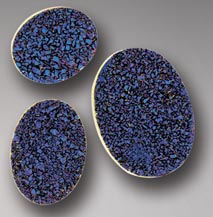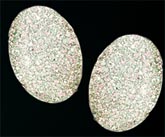BY ANIL DHOLAKIA
Druzy quartz is 100% natural quartz stone that has an agate (quartz) base and a top thin layer of crystalline quartz. The thin layer of crystal growth that is tightly spread out on the base is what gives druzy the beautiful look that makes it such a popular gemstone.
For the past 5 years, I have been pursuing a project to mass produce calibrated and flat surfaces. The small occurrence in Mexico and Brazil in Amethyst and Citrine Druze is no comparison to vast quantities I have acquired in South India, Madhyapradesh and Maharashtra where growth comes from nodules as big as 2 kg per piece. We finally obtained 100 tons of materials in the raw – from which a final stock for 100,000 stones in different calibrations has been produced.
The yield per kg (2.2 lbs) was two or three useable stones with flat and even surface selected from the raw roundish nodules based on the nature of formation. To get stones flat in sizes of 20×15 is almost impossible. So calibrations have been kept to 8, 10, 12 rounds and some 14 mm as well as ovals: 10×12, 10×14, 16×12 and 18×13 ovals.
The uneven stones are produced in free sizes and some are even drilled for beads . We also produce the so called “eye stones” which has flicker on top of the cabs, but is not as attractive as the flat calibrated stones.
The selected quantities of flat and calibrated stones are gathered and collected in our warehouse in Bombay. From there, they are sent a distance of 300 miles to Cambay for the hand oriented process called “hand trimming”, which is done with vertical spike of steel and wooden or steel mallet.
Then, the stones are transported for final grinding and polishing to the Jaipur area factory where we control the thickness, polish and calibration of the final product. The calibrated stones are then returned to Bombay for export to our facility in the USA.
When the final product arrives in the US, it is sorted for different grains of crystal growth before it is sent to Azotic Coating Technology, Inc. in Rochester MN for the final vapor deposition.
The patented Azotic® process is a proprietary procedure that combines different salts and elements at high heat for even distribution of colors and hues. Once treated, the stones are then ready for outsource marketing in their perfected colors of cobalt blue, peacock blue green and green blue hues, S.I. Opal and other shade variations.
Anil B. Dholakia, Inc. is a respected manufacturer and supplier of wholesale quantity Drusy Quartz loose gemstones. Calibrated sizes available in Azotic® designer colors including S.I. Opal and vibrant Cobalt Blue. Visit our Wholesale Gem & Jewelry website to learn more.






You must be logged in to post a comment.